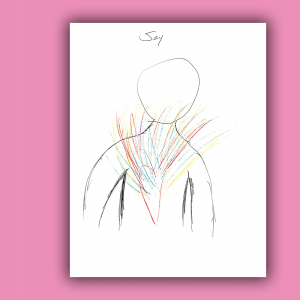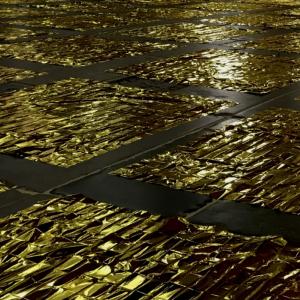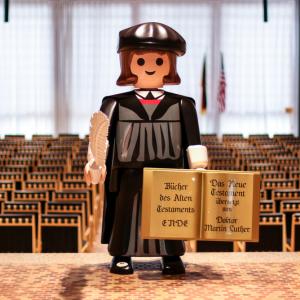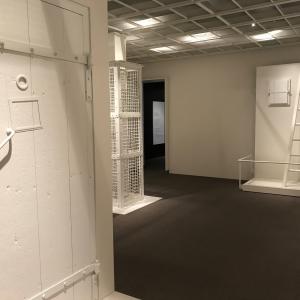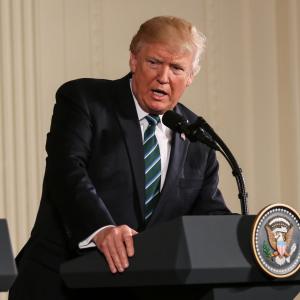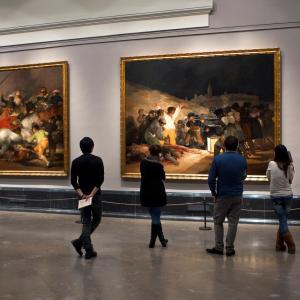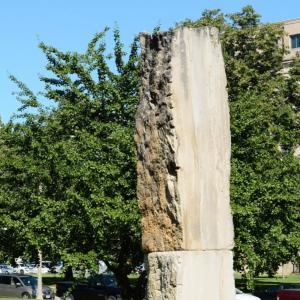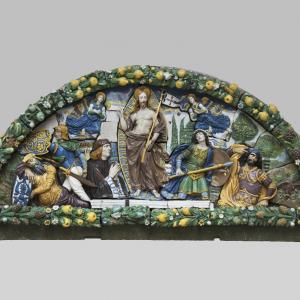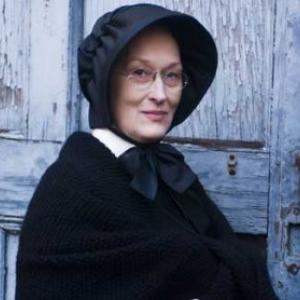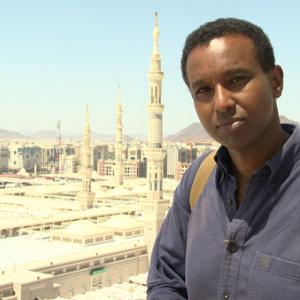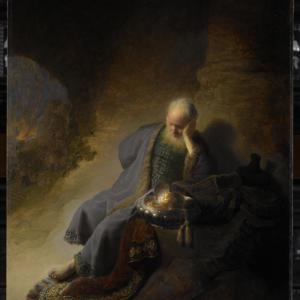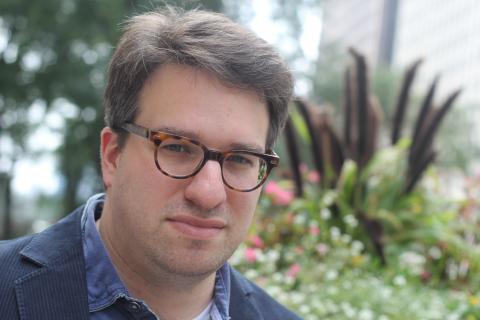
Menachem Wecker writes for the RNS and is a freelance reporter based in Washington, D.C. He holds a graduate degree in art history from George Washington University.
Posts By This Author
Drawing May Be Key to Accessing Spirituality
Exploring art as an access point to the soul.
IT'S LONG BEEN known that empathy may be inherent in portraiture—walking a mile in the shoes of one’s painting subject. As the renowned 15th-century painter and monk Fra Angelico put it, “He who wishes to paint Christ’s story must live with Christ.” New research reinforces this association between artmaking and spirituality.
A 2020 Fetzer Institute study of U.S. spirituality, which includes 16 focus groups and 26 in-depth interviews, reports that more than 80 percent of its 3,600 respondents self-identified as somewhat spiritual, and about 60 percent aspired to be more spiritual. Novelly, researchers used drawings as an “inductive research tool” to understand better what respondents meant by “spirituality,” said Veronica Selzler, lead author of the Fetzer study and strategy director at Hattaway Communications in Washington, D.C. Art allowed participants to define spirituality creatively rather than prescriptively. “It was through these drawings that the diversity and common threads began to emerge,” she said.
The study reproduced 38 drawings in which respondents, aged 18 to 71, interpreted spirituality. The “slightly spiritual/not religious at all” Dale, 69, drew five clouds—one perhaps smiling—and grass as his “happy place, but you could call it a spiritual place.” Daniel, 20, who is “very spiritual/not at all religious,” drew a self-portrait praying on his knees before Jesus.
When Climate Science Is Ignored, Try the Arts
College and university art museums exhibit the dangers facing our environment.
At higher educational arts institutions, green has become the new black. In the last year, museums at Bowdoin College, Brown University, Princeton University, University of Colorado Boulder, University of Maryland, University of Michigan, University of Utah, and Yale University have convened environmental and climate change-focused programming and exhibitions, with titles ranging from “Sea of Troubles: Rising Seas & Sinking Cities” to “Before the Deluge: Apocalyptic Floodscapes from John Martin to John Goto, 1789 to Now.”
The focus on nature and the dangers facing the environment raises the question: Are there unique opportunities and challenges for college and university art museums when addressing the environment? And more fundamentally: Can an art exhibit do more than simply preach—albeit beautifully—to the choir?
First and foremost, the humanities offer “effective, compelling storytelling,” according to Jeffrey J. Cohen, dean of humanities at Arizona State University, co-president of the Association for the Study of Literature and the Environment, and a teacher of environmental humanities.
When a Church Becomes an Art Installation
Mylar blankets turn a Dutch church into a meditation on migration.
WHEN DUTCH ARTIST Sarah van Sonsbeeck sees photos of people wrapped in metallic emergency blankets and referred to as “migrants” or “refugees,” she’s disturbed by the way this reduces their humanity. “This abstraction, I feel, is very dangerous,” she says.
Van Sonsbeeck brought hundreds of gold-and-silver Mylar blankets to Amsterdam’s Oude Kerk (“Old Church”) for a site-specific installation last May to September. The exhibit reflected upon the church’s colonialist history and the ways that Westerners can be unwittingly complicit in migration. The last point troubled the artist from the start of her project.
“As I am not a migrant, am I even entitled to address this?” she asked herself, before realizing she too plays a role. “I belong to and am a product of the Western society the migrants are migrating to,” she says.
Just as Mylar blankets can obscure people’s humanity, van Sonsbeeck’s installation, which evoked ripples in a golden sea when the light hit off the Mylar, covered many of the 2,500 tombstones marking some 10,000 graves that make up the church floor. Some of Amsterdam’s most prominent business people, politicians, and military leaders are buried beneath the 13th century church, and Rembrandt’s wife, Saskia van Uylenburgh, is another renowned long-term resident.
How Did Martin Luther Become So Popular?
How the 16th Century Monk's Writings Went Viral
Luther's is the story of “how an obscure university professor developed a commercial identity through skillful exploitation of the high-tech media of his day.”
The Aesthetics of Horror
New Exhibit Focuses on the Architects of Nazi Gas Chambers
It’s easy to associate the worst crimes of the Nazi regime with the leading villains — Adolf Hitler, Hermann Göring, Heinrich Himmler, Joseph Goebbels. But it took countless faceless bureaucrats, sitting in offices, pushing paper, and drafting plans, to enable the Nazi state. The manufacturer J.A. Topf built the crematoria, and coal miners and steel makers produced raw materials for the machinery of the concentration camps.
Can the Incarceration of Japanese Americans Shed Light on Today’s Immigration Questions?
“Then They Came For Me” marks the 75th anniversary of President Franklin Roosevelt’s signing of Executive Order 9066, which authorized the internment of all people on the West Coast thought to be a threat to national security.
Jewish Trump Supporters Resist Calls From Other Jews to Renounce the President
In past weeks — in the wake of Trump comments about white supremacy widely condemned as too late and too soft — disagreements among Jews about the president played out on a very public stage
Can Art Shed Light on the Ethics of Capital Punishment?
More than 50 years later, California still lists lethal gas as a legal execution means. So do five other states: Arizona, Mississippi, Missouri, Oklahoma, and Wyoming, although Mississippi and Oklahoma, which use nitrogen hypoxia, don’t use that term. (More on that below). I learned this as I searched on my phone standing in front of John Singer Sargent’s monumental 1919 painting “Gassed,” which is on display in the New-York Historical Society’s exhibition “World War I Beyond the Trenches” (through Sept. 3).
Iowa Is Known for Its Politics, But What About Religious Diversity?
The book’s text and photographs, which profile 15 Buddhist, Christian, Hindu, Jewish, Muslim, and Sikh communities, collectively demonstrate what Patel views as “something that I believe cities all over the United States and the world should seek to emulate.”
At the National Gallery, a Family History On Display
“It’s quite unique for us,” Antinori, whose mother’s family includes three popes in the 18th and 19th centuries, said. “To have the commissioner — our ancestor, in this case — also represented in a piece is unique.”
Hollywood’s Depiction of Nuns a Case of ‘Veiled Desires’
From Julie Andrews’ performance as Maria in the 1965 film “The Sound of Music” to Meryl Streep’s portrayal of Sister Aloysius Beauvier in “Doubt” (2008), many Hollywood actresses are particularly conspicuous for their habits. But although habits or veils are thought to symbolize purity – and especially chastity — some films presented a more complicated portrait of nuns.
The title of Maureen Sabine’s new book, “Veiled Desires: Intimate Portrayals of Nuns in Postwar Anglo-American Film” (Fordham University Press), refers to the paradox of having charismatic and photogenic actresses playing chaste nuns and, in the process, drawing attention to the desires their habits were thought to stifle.
‘God is the Best Artist’ Takes Off on Social Media
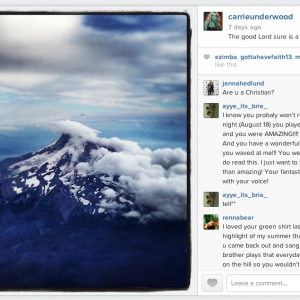
Screenshot of post on Carrie Underwood's Instagram feed. Photo courtesy http://instagram.com/.
The notion of God as an artist is hardly new. In the Middle Ages, the concept of a divine artist, or architect, was often invoked. The biblical artists Bezalel and Oholiab are described as being “full of the spirit of God.” In Catholic art, angels often guide St. Luke’s hand when he draws the Virgin.
But when Twitter and Pinterest users take to their smartphones to snap pictures of sunrises and sunsets and attribute those “masterpieces” to God, they are exhibiting a new sort of adoration.
PBS' Series 'Life of Muhammad' May Surprise Viewers
He’s born poor. By age 6, he’s an orphan. Two years later, he loses his grandfather. Yet he overcomes his circumstances, develops a reputation for business integrity and progressive views on marriage.
Then he becomes a prophet of God.
The portrait of the Muslim prophet, which emerges from a PBS documentary “Life of Muhammad,” may surprise some American viewers.
Orthodox Jews to Observe July Fourth Without Music
The soundtrack for a lot of Orthodox Jews this Fourth of July will be the mute button.
As music gallantly streams at barbecues and fireworks displays across the nation, many Orthodox Jews will silence their TVs and avoid live music performances, such as the annual Boston Pops concert on the Esplanade Hatch Shell.
As it does every three years or so, Independence Day falls during a three-week Jewish mourning period, circumscribed by two fast days: the 17th of Tammuz, which falls on June 25 and Tisha B’Av, which falls on July 16.
